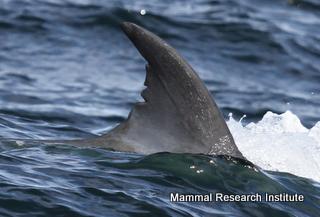Gwenith Susan Penry
To produce a range wide abundance estimate of the South African inshore Bryde’s whale population, determine their current dietary requirements and use this information to assess the conservation needs of this small, spatially restricted population.

Common Dolphins at False Bay.
Bryde’s whales are classified as ‘data deficient’ by the International Union for Conservation of Nature (IUCN) and confusion remains over the number of discrete populations that exist. At an estimated 582 (SE 184) individuals in 1983, the South African inshore population has the smallest intrinsic population size of any large whale occurring in the region, and has been shown to be genetically distinct from the offshore population. Few dedicated studies on this population have occurred and insufficient information is available to assess their current status. Due to their residency in coastal waters and dependency on small pelagic fish, inshore Bryde’s whales are vulnerable to the effects of overfishing and ecosystem changes that influence the distribution of their prey. Recent studies indicate a decline in other top predator species (e.g. African penguins) also dependent on pelagic fish in South African waters, supporting the need to assess the possible effects of declining prey availability on the inshore Bryde’s whale population. Between 2005 and 2008, a photo-identification study on the southeast coast of South Africa produced an abundance estimate of between 150 and 250 individuals. This is lower than in 1983, but can be explained by the spatial limitations to sampling, resulting in an estimate that is unrepresentative of the entire population.

A highly distinctive dorsal fin of a Bryde’s whale photographed in False Bay, Cape Town.
The development of a robust, range-wide estimate of current population size is therefore a conservation imperative. This will be achieved using small boat surveys in three sites (False Bay, Plettenberg Bay and East London) throughout their range. Photo-identification and molecular (genotypes) data on individuals will be collected and used in mark-recapture models for estimating abundance. Additionally, the effects of pelagic fish exploitation on the trophic level at which this population feeds will be investigated. This will be achieved through the analysis of stable isotope signatures in the baleen of stranded individuals and skin from live, biopsy sampled individuals. Their current dietary contribution will be compared to historical records of stomach contents.
The findings of this project will allow trends in population size and changes in prey selection to be observed. Data on abundance and dietary requirements of the Bryde’s whale population will be presented to potential decision makers, particularly those responsible for setting quotas for the small pelagic fishing industry. Incorporating this information into a ‘predator allowance’ will help to ensure sufficient prey availability for all predators of small pelagic fish such as sardine and anchovy.